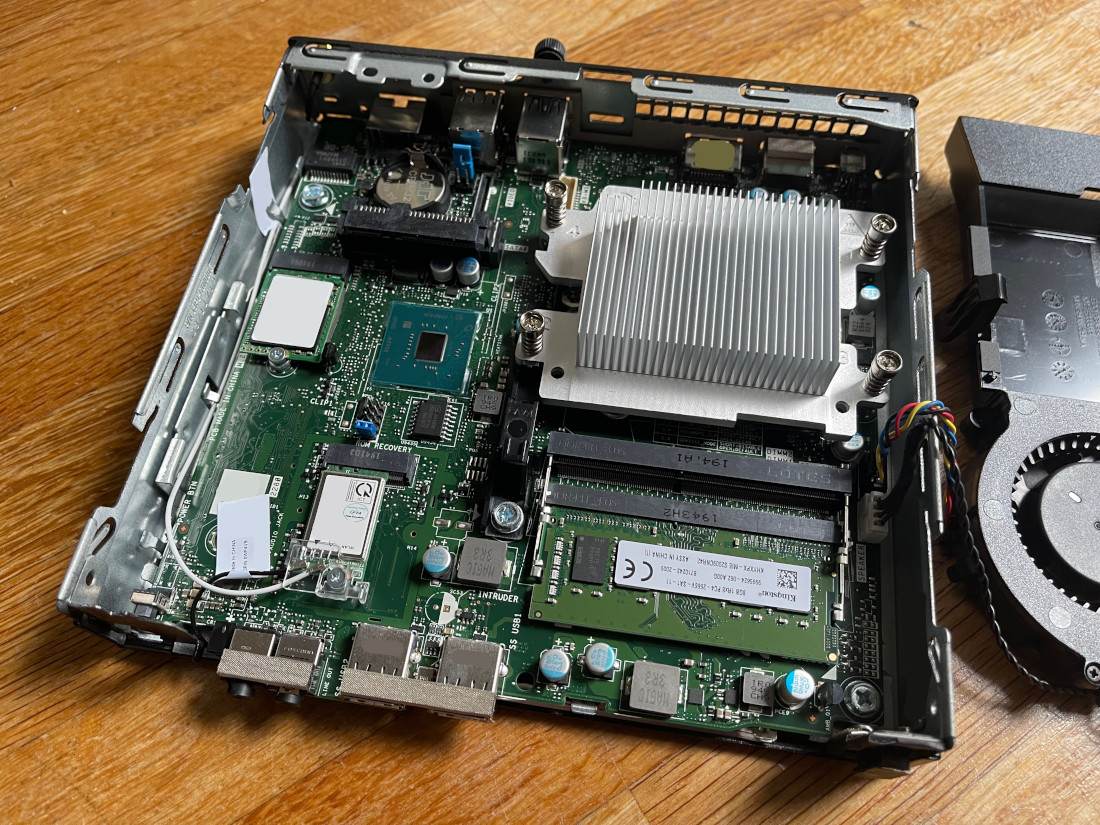Dell Optiplex 3070 Micro
Two years later and it's time to add another mini server to the collection, this time in the form of a Dell Optiplex 3070 Micro (courtesy of CEX). Over the last two years the Lenovo mini server I have has been running great and hasn't missed a beat, so with a view on reducing costs (especially power usage) a migration from the larger rack-mounted servers to micro servers continues to progress.
Insides
The functionality / expandability of this system is almost on par with the Lenovo, however there are a few quirks that I will cover later.
- Intel Core i5-9500T CPU
- 2 SODIMM slots (for up to 64GB RAM)
- m.2 NVMe full-length slot
- Onboard Intel GPU (shared memory)
- HDMI and DisplayPort output
- Gigabit Ethernet (Realtek chipset)
- Internal SATA-3 port for 2.5" SSD
- Multiple USB2 and USB3 ports
- USB-C/Thunderbolt port

Another compact layout, with every bit of space accounted for

A good design, but the lack of PCIe expansion and rigid SATA is disappointing
RAM Upgrade
The initial plan was to use the 32GB SODIMMs I have from the SolidRun servers, with the caveat that while they are ECC SODIMMSs these CPUs don't support ECC. Unfortunately even with the latest BIOS the system would not POST using these (the usual combination of beep codes). I took a chance and swapped the ECC SODIMMs into the Lenovo PC where they worked (and are working) without issue, which allowed me to run the Lenovo SODIMMs in the Dell getting it to 64GB. Both systems are running stable from a memory perspective and money saved!
Expansion
In short, it's limited... There isn't a riser-based PCIe port to use (unlike the Lenovo), so you are limited to Thunderbolt on the rear. Internally you could remove the WiFi card and use that slot, but that still isn't great. The SATA port is also rigid meaning you can't stuff anything else inside the case (less of an issue overall).
Quirks
This unit isn't without a few quirks to make things 'interesting'... The inability to support ECC RAM is a little odd but not unheard of, and as it isn't something that support is advertised for it is more of a FYI than anything else.
The HDMI port is definitely something I would consider a quirk, as despite going through all of the BIOS settings the system does not like displaying the boot output/BIOS/UEFI through it. Once the OS is loaded the port works fine, but for initial setup I found DisplayPort needed to be used otherwise you weren't getting any output.
The onboard Ethernet is where things get strange... I'm not sure if this is a subtle hardware fault or a BIOS quirk or just a Realtek NIC being a Realtek NIC... Trying to use Linux with the onboard NIC was problematic to say the least, as earlier version of the Linux kernel would be flooded with ACPI errors related to the DSDT and the network adapter. Upgrading to a 6.x kernel helped resolve that (no more errors), however the card was still remarkably unstable / performed terribly. A few forum posts recommended switching from the built-in r8169 driver to the DKMS r8168 driver, which thankfully resolved the stability issues and also significantly improved the performance. There are still AER errors being generated (thankfully indicating correction events rather than failures), but either way they aren't good (pcieport 0000:00:1c.0: AER: Corrected error received: 0000:01:00.0).
Virtualization
While running ESXi on this system is tempting, the quirks would potentially make it a painful experience for little gain. Instead I have gone down the Docker path, using it to hosts different containers and acting as a test-bed for the new and interesting.
Current Status
So far so good, with great performance and stability being as I would expect. I'm hoping this system lasts for a few years given there is still plenty of headroom and from a power consumption perspective it is lower than I expected.